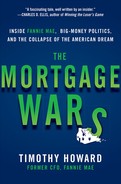Acknowledgments
Countless people suggested that I write this book. For nearly eight years after being asked to leave Fannie Mae at the end of 2004, I was advised by my personal counsel not to speak publicly about my experience at the company because of pending litigation. When I talked about it privately with friends and acquaintances, however—whether to explain how in just five years Fannie Mae could have gone from being one of the most successful companies in the country to being put into conservatorship, or to give them the back story on the accounting allegations leveled by its regulator—they invariably had the same reaction: “You have to write a book about that!”
I didn’t think I ever would, but three things happened to change my mind. First, more and more was written about Fannie Mae and the financial crisis, and the story that was told about the company bore little resemblance to what I knew and had lived through firsthand. Second, in late August 2011, lawyers in the Fannie Mae civil suit in which I was named as a defendant filed a series of motions with the presiding judge that contained important information about the regulatory assault on the company not disclosed previously. Because these motions were made public, I would be able to refer to their contents in anything I wrote.
I began work on the book shortly after the motions were filed, but I did not definitely decide to go ahead with it until October 2012, when the judge emphatically dismissed me from the civil suit. That dismissal allowed me to write more freely about the mortgage wars and also, by restoring my public identity as a career financial executive and risk manager rather than as the suspected architect of an accounting fraud, gave me a much more credible platform from which to do so.
I have written numerous papers, presentations, and speeches during my business career, but a full-length book is a very different matter. Early on in the project, a former Fannie Mae colleague who also is a published author, John Buckley, put me in contact with an agent at Folio Literary Management in New York, Scott Hoffman. Scott is the reason this book exists. As a first-time author, my earliest drafts of a story outline fell well short of what most publishers look for, but rather than reject them, Scott made valuable suggestions for reshaping and refining them to the point where I finally had something he could send to editors. Tom Miller at McGraw-Hill saw the potential in the book, made an offer to publish it, and we were off and running.
Writing, I found, is a full-time and solitary job. The book took much longer to write than I expected it to, and during that time I could not have asked for more or better support than I received from my wife, Debbie. If she ever got tired of hearing me say, “I can’t do that now; I have to work on the book,” she never let on. For that I am deeply in her debt. I am also grateful to our many friends who indulged our requests to be allowed to drop off their radar screens for extended periods of time while I toiled away at my new vocation.
As the book was being written, I sent working drafts of chapters and sections to a number of people for their review and comments. I specifically want to thank Frank Raines, Bill Maloni, Tom Lawler, Jonathan Boyles, and Barry Zigas for the time they took to go over the material and for the very helpful comments they offered and the corrections they made. After the initial draft was finished, my editor, Tom Miller, made several useful suggestions on organization and presentation that significantly improved the final product. That product may bear my name, but it reflects the support, assistance, and indulgence of a great many people of whom I am enormously appreciative.
